expository writing(examples)
- 格式:doc
- 大小:198.00 KB
- 文档页数:19
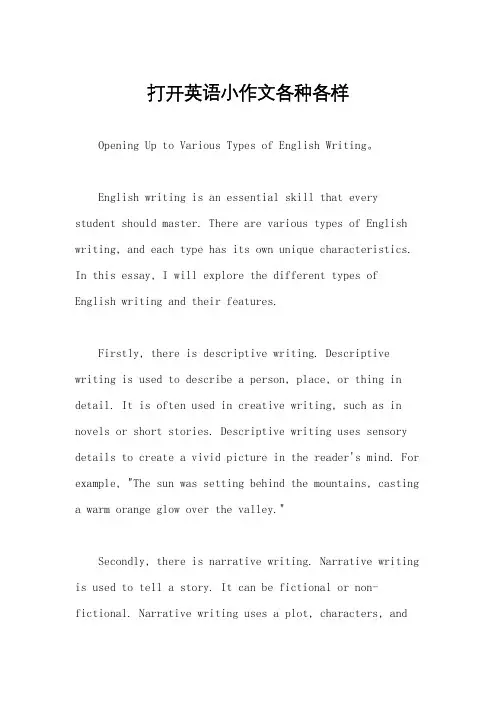
打开英语小作文各种各样Opening Up to Various Types of English Writing。
English writing is an essential skill that every student should master. There are various types of English writing, and each type has its own unique characteristics. In this essay, I will explore the different types of English writing and their features.Firstly, there is descriptive writing. Descriptive writing is used to describe a person, place, or thing in detail. It is often used in creative writing, such as in novels or short stories. Descriptive writing uses sensory details to create a vivid picture in the reader's mind. For example, "The sun was setting behind the mountains, casting a warm orange glow over the valley."Secondly, there is narrative writing. Narrative writing is used to tell a story. It can be fictional or non-fictional. Narrative writing uses a plot, characters, andsetting to engage the reader. It is often used in novels, short stories, and memoirs. For example, "Once upon a time, there was a little girl named Red Riding Hood who lived in a small village in the woods."Thirdly, there is persuasive writing. Persuasivewriting is used to persuade the reader to take a particular action or adopt a particular viewpoint. It is often used in advertisements, speeches, and opinion pieces. Persuasive writing uses facts, statistics, and emotional appeals to convince the reader. For example, "Join us in the fight against climate change by reducing your carbon footprint today."Fourthly, there is expository writing. Expository writing is used to explain a concept or idea. It is often used in textbooks, research papers, and essays. Expository writing uses facts, examples, and evidence to support the writer's argument. For example, "Global warming is caused by the increase in greenhouse gases in the atmosphere, such as carbon dioxide and methane."Lastly, there is reflective writing. Reflective writing is used to reflect on a personal experience or event. It is often used in journals, diaries, and personal essays. Reflective writing uses introspection and self-analysis to explore the writer's feelings and thoughts. For example, "Looking back on my childhood, I realize how much my parents sacrificed for me and how grateful I am for their love and support."In conclusion, there are various types of English writing, each with its own unique features and purposes. By understanding the different types of writing, students can improve their writing skills and communicate effectively in different contexts.。
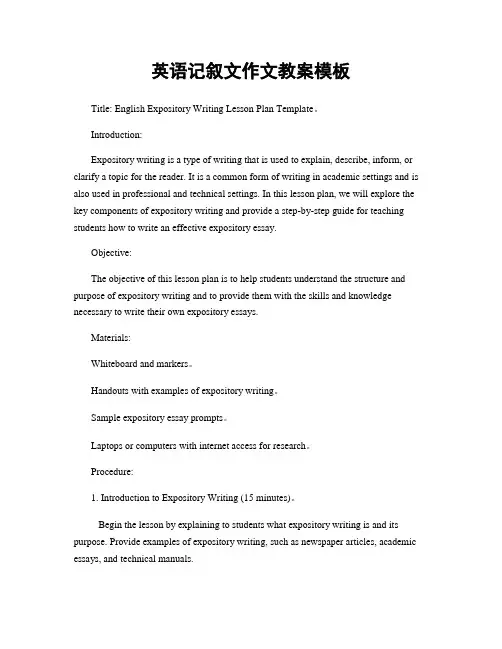
英语记叙文作文教案模板Title: English Expository Writing Lesson Plan Template。
Introduction:Expository writing is a type of writing that is used to explain, describe, inform, or clarify a topic for the reader. It is a common form of writing in academic settings and is also used in professional and technical settings. In this lesson plan, we will explore the key components of expository writing and provide a step-by-step guide for teaching students how to write an effective expository essay.Objective:The objective of this lesson plan is to help students understand the structure and purpose of expository writing and to provide them with the skills and knowledge necessary to write their own expository essays.Materials:Whiteboard and markers。
Handouts with examples of expository writing。
Sample expository essay prompts。
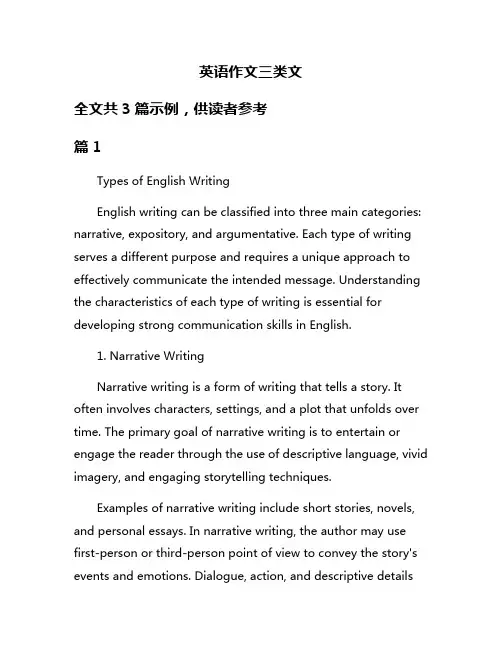
英语作文三类文全文共3篇示例,供读者参考篇1Types of English WritingEnglish writing can be classified into three main categories: narrative, expository, and argumentative. Each type of writing serves a different purpose and requires a unique approach to effectively communicate the intended message. Understanding the characteristics of each type of writing is essential for developing strong communication skills in English.1. Narrative WritingNarrative writing is a form of writing that tells a story. It often involves characters, settings, and a plot that unfolds over time. The primary goal of narrative writing is to entertain or engage the reader through the use of descriptive language, vivid imagery, and engaging storytelling techniques.Examples of narrative writing include short stories, novels, and personal essays. In narrative writing, the author may use first-person or third-person point of view to convey the story's events and emotions. Dialogue, action, and descriptive detailsare often used to create a compelling narrative that draws the reader in and holds their attention until the end.2. Expository WritingExpository writing is a form of writing that explains or informs the reader about a specific topic or subject. The primary goal of expository writing is to present factual information in a clear and concise manner. This type of writing often includes research, analysis, and logical reasoning to support the writer's ideas and arguments.Examples of expository writing include essays, articles, and reports. In expository writing, the author presents evidence, examples, and explanations to help the reader understand the topic or issue being discussed. The writing style is often formal and objective, with a focus on clarity and coherence in presenting complex ideas or concepts.3. Argumentative WritingArgumentative writing is a form of writing that presents a claim or argument and supports it with evidence, reasoning, and persuasive language. The primary goal of argumentative writing is to convince the reader to agree with the writer's point of view or take a specific action. This type of writing often involvesanalyzing and evaluating different perspectives on a controversial issue.Examples of argumentative writing include persuasive essays, opinion pieces, and editorials. In argumentative writing, the author presents a clear thesis statement or main argument and uses logical reasoning, facts, and examples to support their position. Counterarguments and refutations may also be included to address opposing viewpoints and strengthen the writer's argument.In conclusion, understanding the different types of English writing – narrative, expository, and argumentative – is essential for developing effective communication skills. By mastering the techniques and conventions of each type of writing, writers can effectively convey their ideas, engage their readers, and achieve their communication goals.篇2Types of English CompositionEnglish composition is a ubiquitous form of writing that is taught in schools at various levels. There are several types of English composition, each with its own purpose, structure, andstyle. In this article, we will explore three main types of English composition: narrative, expository, and argumentative.Narrative CompositionNarrative composition is essentially storytelling. It is a form of writing that is used to tell a story, usually in chronological order. Narrative compositions often include characters, a setting, a plot, and a resolution. The purpose of a narrative composition is to entertain, engage, and evoke emotions in the reader.In a narrative composition, the writer uses descriptive language to create vivid images and bring the story to life. The writer may also use dialogue to develop characters and propel the plot forward. Additionally, narrative compositions often include sensory details to make the reader feel as though they are experiencing the events themselves.Expository CompositionExpository composition is a type of writing that is used to explain, inform, or describe a topic. It is non-fiction writing that presents facts, ideas, and information in a clear and organized manner. Expository compositions often include a thesis statement, supporting evidence, and a conclusion.In an expository composition, the writer uses logical reasoning, examples, and evidence to explain a topic. The writer may also use compare and contrast, cause and effect, or problem-solution structures to organize the information. Additionally, expository compositions may include definitions, descriptions, and explanations to help the reader understand the topic.Argumentative CompositionArgumentative composition is a type of writing that is used to persuade, convince, or argue a point. It is a form of writing that presents a claim, supports it with evidence, and refutes counterarguments. Argumentative compositions often include a thesis statement, supporting arguments, and a conclusion.In an argumentative composition, the writer uses persuasive language, logic, and evidence to support their claim. The writer may also anticipate and address counterarguments to strengthen their position. Additionally, argumentative compositions may include appeals to emotion, ethics, or logic to persuade the reader.In conclusion, narrative, expository, and argumentative compositions are three main types of English composition. Each type serves a different purpose and requires a different approachto writing. By understanding the characteristics of each type, writers can choose the most appropriate form of composition to communicate their ideas effectively.篇3Three Types of English WritingEnglish writing can be broadly categorized into three main types: narrative, descriptive, and argumentative. Each type of writing serves a different purpose and requires unique elements to be effective. Understanding the differences between these types of writing can help writers improve their skills and tailor their writing to different audiences and situations.Narrative writing is often used to tell a story or recount events. This type of writing typically includes a plot with a beginning, middle, and end, as well as characters, setting, and conflict. Narrative writing is often used in fiction, but it can also be used in non-fiction to convey personal experiences or recount historical events. The key elements of narrative writing are a strong voice, clear structure, and engaging storytelling.Descriptive writing is used to paint a vivid picture of a person, place, object, or experience. This type of writing uses sensory details to create an image in the reader's mind. Descriptivewriting can be used in fiction to create a sense of atmosphere and mood, or in non-fiction to provide detailed descriptions of people, places, or events. The key elements of descriptive writing are vivid language, sensory details, and a focus on creating a specific mood or tone.Argumentative writing is used to persuade or convince readers to take a particular stance on an issue. This type of writing presents a clear thesis or argument, supported by evidence and reasoning. Argumentative writing is often used in essays, editorials, and persuasive speeches. The key elements of argumentative writing are a strong thesis, logical organization, and persuasive language.Each type of writing has its own unique challenges and requirements. Narrative writing requires a strong voice and engaging storytelling, descriptive writing relies on vivid language and sensory details, and argumentative writing demands a clear thesis and persuasive reasoning. By understanding the differences between these types of writing, writers can improve their skills and effectively communicate their ideas to their intended audience.。
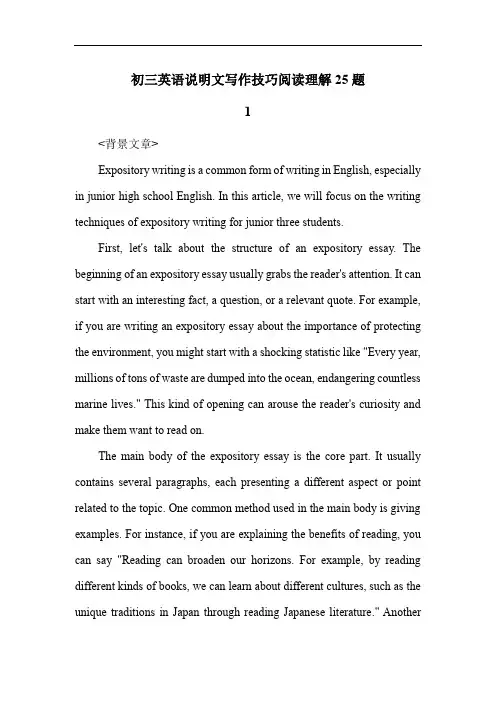
初三英语说明文写作技巧阅读理解25题1<背景文章>Expository writing is a common form of writing in English, especially in junior high school English. In this article, we will focus on the writing techniques of expository writing for junior three students.First, let's talk about the structure of an expository essay. The beginning of an expository essay usually grabs the reader's attention. It can start with an interesting fact, a question, or a relevant quote. For example, if you are writing an expository essay about the importance of protecting the environment, you might start with a shocking statistic like "Every year, millions of tons of waste are dumped into the ocean, endangering countless marine lives." This kind of opening can arouse the reader's curiosity and make them want to read on.The main body of the expository essay is the core part. It usually contains several paragraphs, each presenting a different aspect or point related to the topic. One common method used in the main body is giving examples. For instance, if you are explaining the benefits of reading, you can say "Reading can broaden our horizons. For example, by reading different kinds of books, we can learn about different cultures, such as the unique traditions in Japan through reading Japanese literature." Anotheruseful method is using numbers. When writing about the growth of the population, numbers like "The world's population has reached over 7 billion" can make the statement more convincing. Making comparisons is also a good way. If you are writing about the differences between traditional schools and online schools, you can say "Traditional schools offer face - to - face interaction with teachers and classmates, while online schools provide more flexibility in terms of study time."The ending of an expository essay is also very important. It should summarize the main points of the essay and leave a deep impression on the reader. It can be a call to action, a prediction, or a restatement of the thesis. For example, in an essay about environmental protection, the ending could be "Let's take action now to protect our environment for the future generations."In terms of language features, expository writing emphasizes accuracy. Writers need to use precise words to convey their ideas clearly. For example, instead of using "a lot of", you can use "numerous" or "plentiful" when appropriate. At the same time, simplicity is also valued. Avoid using overly complicated sentence structures and rare words that may make the reader confused.1. <问题1>A. What is the main purpose of the beginning of an expository essay?A. To present the conclusion directly.B. To attract the reader's attention.C. To list all the examples.D. To introduce the writer's personal experience.答案:B。
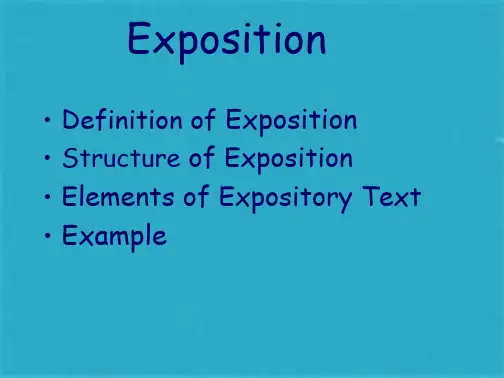
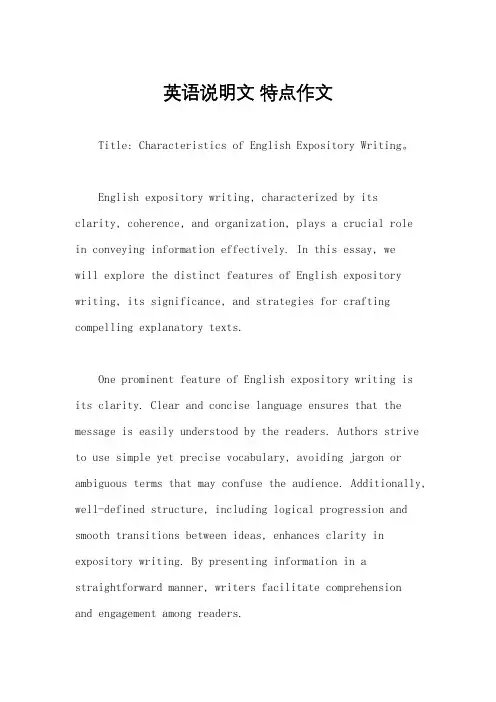
英语说明文特点作文Title: Characteristics of English Expository Writing。
English expository writing, characterized by itsclarity, coherence, and organization, plays a crucial rolein conveying information effectively. In this essay, wewill explore the distinct features of English expository writing, its significance, and strategies for crafting compelling explanatory texts.One prominent feature of English expository writing is its clarity. Clear and concise language ensures that the message is easily understood by the readers. Authors strive to use simple yet precise vocabulary, avoiding jargon or ambiguous terms that may confuse the audience. Additionally, well-defined structure, including logical progression and smooth transitions between ideas, enhances clarity in expository writing. By presenting information in a straightforward manner, writers facilitate comprehensionand engagement among readers.Coherence is another essential characteristic of English expository writing. Coherence refers to the logical connection between ideas within a text, ensuring that each paragraph or section contributes to the overall understanding of the topic. Writers achieve coherence through the use of cohesive devices such as transitional words and phrases, repetition of key concepts, and consistent referencing throughout the text. This cohesive structure guides readers through the content seamlessly, enabling them to follow the author's line of reasoning without confusion.Organization is fundamental to effective expository writing in English. A well-organized essay follows a clear structure, typically consisting of an introduction, body paragraphs, and a conclusion. The introduction sets the stage by presenting the topic and establishing the purpose of the essay, often including a thesis statement that outlines the main argument or point of view. Body paragraphs develop the thesis through the presentation of evidence, analysis, and examples, arranged in a logicalsequence to support the central argument. Finally, the conclusion summarizes the key points and restates the thesis, providing closure to the discussion.In addition to clarity, coherence, and organization, English expository writing prioritizes objectivity and evidence-based reasoning. Authors strive to present information impartially, relying on facts, data, and expert opinions to support their claims. Avoiding personal bias or emotional language enhances the credibility of the text and fosters trust among readers. Furthermore, writers often incorporate citations and references to acknowledge the sources of information and demonstrate the depth of their research.Effective English expository writing also engages the audience through various rhetorical strategies. These may include the use of anecdotes, analogies, statistics, or quotations to illustrate key points and capture thereader's interest. Additionally, writers may employ rhetorical devices such as parallelism, rhetorical questions, or antithesis to add emphasis and persuasiveappeal to their arguments. By incorporating theserhetorical elements strategically, authors can enhance the persuasiveness and impact of their expository writing.In conclusion, English expository writing is characterized by its clarity, coherence, organization, objectivity, and engagement. By employing these features effectively, writers can convey information in a compelling and accessible manner, facilitating understanding and communication among diverse audiences. Whether in academic essays, journalistic articles, or instructional manuals, the principles of English expository writing remain essential for conveying ideas effectively in written form.。
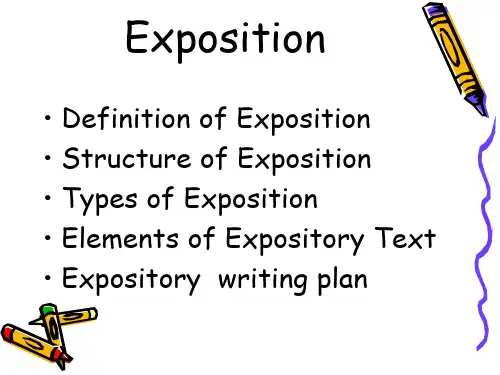
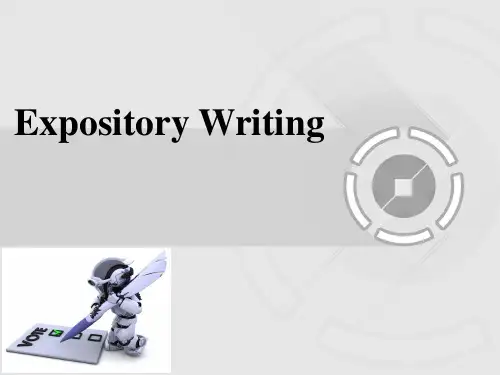
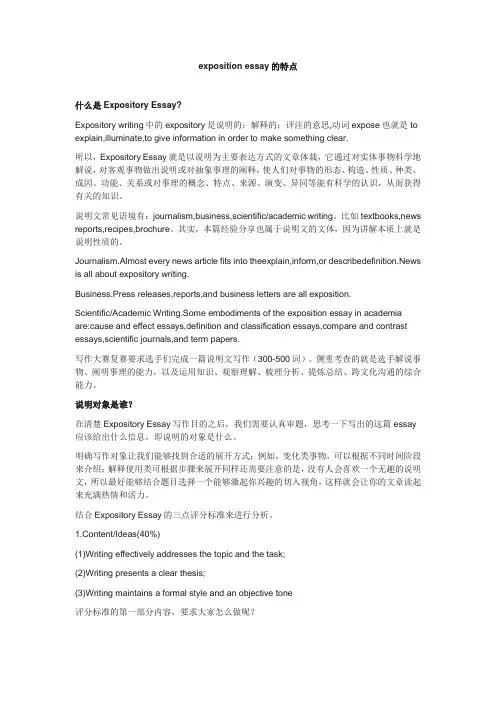
exposition essay的特点什么是Expository Essay?Expository writing中的expository是说明的;解释的;评注的意思,动词expose也就是to explain,illuminate,to give information in order to make something clear.所以,Expository Essay就是以说明为主要表达方式的文章体裁,它通过对实体事物科学地解说,对客观事物做出说明或对抽象事理的阐释,使人们对事物的形态、构造、性质、种类、成因、功能、关系或对事理的概念、特点、来源、演变、异同等能有科学的认识,从而获得有关的知识。
说明文常见语境有:journalism,business,scientific/academic writing。
比如textbooks,news reports,recipes,brochure。
其实,本篇经验分享也属于说明文的文体,因为讲解本质上就是说明性质的。
Journalism.Almost every news article fits into theexplain,inform,or describedefinition.News is all about expository writing.Business.Press releases,reports,and business letters are all exposition.Scientific/Academic Writing.Some embodiments of the exposition essay in academia are:cause and effect essays,definition and classification essays,compare and contrast essays,scientific journals,and term papers.写作大赛复赛要求选手们完成一篇说明文写作(300-500词)。
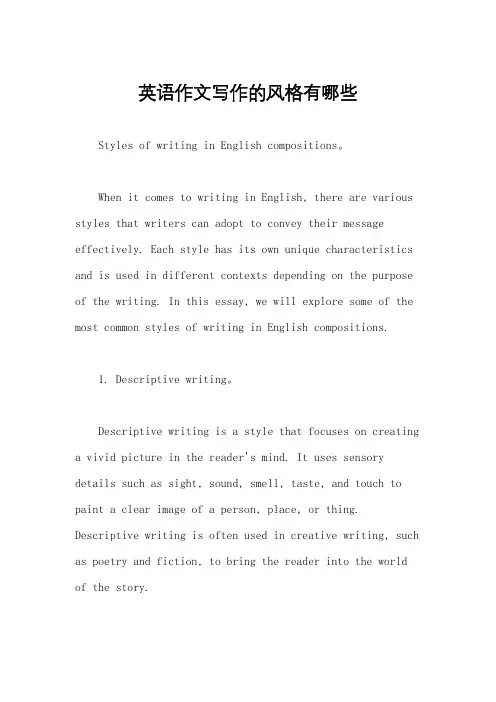
英语作文写作的风格有哪些Styles of writing in English compositions。
When it comes to writing in English, there are various styles that writers can adopt to convey their message effectively. Each style has its own unique characteristics and is used in different contexts depending on the purpose of the writing. In this essay, we will explore some of the most common styles of writing in English compositions.1. Descriptive writing。
Descriptive writing is a style that focuses on creating a vivid picture in the reader's mind. It uses sensory details such as sight, sound, smell, taste, and touch to paint a clear image of a person, place, or thing. Descriptive writing is often used in creative writing, such as poetry and fiction, to bring the reader into the world of the story.Example:The sun dipped below the horizon, casting a warm golden glow over the tranquil lake. The water shimmered like a thousand diamonds, reflecting the colors of the sky. Theair was filled with the sweet scent of blooming flowers, and the sound of birds chirping in the distance created a symphony of nature.2. Narrative writing。
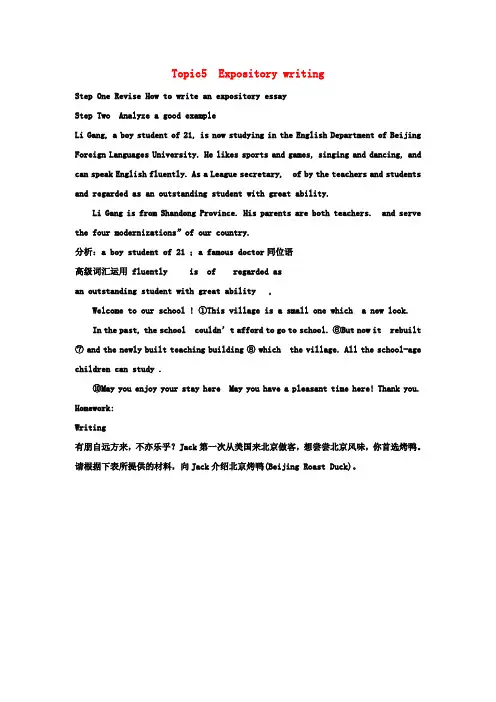
Topic5 Expository writingStep One Revise How to write an expository essayStep Two Analyze a good exampleLi Gang, a boy student of 21, is now studying in the English Department of Beijing Foreign Languages University. He likes sports and games, singing and dancing, and can speak English fluently. As a League secretary, of by the teachers and students and regarded as an outstanding student with great ability.Li Gang is from Shandong Province. His parents are both teachers. and serve the four modernizations”of our country.分析:a boy student of 21 ;a famous doctor同位语高级词汇运用 fluently is of regarded asan outstanding student with great ability ,Welc ome to our school ! ①This village is a small one which a new look.In the past, the school couldn’t afford to go to school. ⑥But now it rebuilt ⑦ and the newly built teaching building ⑧ which the village. All the school-age children can study .⑩May you enjoy your stay here May you have a pleasant time here! Thank you. Homework:Writing有朋自远方来,不亦乐乎?Jack第一次从美国来北京做客,想尝尝北京风味,你首选烤鸭。
1 Expository Writing The expository essay is written to explain or inform. There are a variety of ways to organize an expository essay, depending on your purpose. The most common strategies include development by example, definition, comparison and contrast, division and classification, process analysis, and causal analysis.
Unit1. College Life (Writing Strategy: development by example ) Principles In this unit, we will focus on the example / illustration essay. This type of expository writing involves using examples to support your general statement or explain your idea: ●You may use relevant facts, statistics, personal experiences, incidents, or stories to explain, illustrate, or support the point in your essay. ● The number of examples you use in an example essay depends on the topic of your writing: 1. In some cases, you may find that a series of short examples fit your purpose, illustrating clearly the idea you are presenting to your reader; 2. You may decide that two or three examples, explained in some detail, provide the best support for your topic; or 3. You may also find that in some cases, one long, detailed example is more useful than several shorter ones. ●To make the flow of thoughts smooth, you may use two ways to connect the paragraphs: 1. Use transitional expressions; 2. Use repetition of key words and phrases. Sample A Read the following essay about college students’ out-of-class activities, and
● find the thesis statement, four examples and the conclusion; ● pay attention to how the writer uses the four examples to support a point; ● study the structural elements that hold the essay together. Out-of-Class Activities 1. All work and no play can be almost as bad as all play and no work. Getting your degree should be one of your main goals. Your college classes should, and do, occupy much of your time, but you also need to develop friendships and get involved in other activities. Involvement in extracurricular groups promotes interpersonal communication and leadership skills. Many students think that the only place to meet people on campus is the student union or student center. However, many other groups provide opportunities for enjoying fellowship with other students. -→thesis statement 2. First, students may join a sports group, which organizes athletic events and services for students. These activities focus on competition that encourages sportsmanship and leadership as well as improves health and gives fun. Second, students interested in the same subject often form a club through the student affairs office. This helps them develop friendships with others. Third, students might join other kinds of clubs on campus that involve individuals with similar interests or hobbies. Membership often depends on grade point average or other criteria. Finally, leisure or other noncredit courses also provide opportunities for you to meet others. -→ four examples 3. In general, students can always take part in some kind of out-of-class activities and communicate with other people to develop their social skills. Thus, they no longer simply attend college; they are part of college life. ↓conclusion Sample B In colleges and universities, there are many students’ organizations. If you are going to write an essay about an organization in your university and tell people how good it is, how will you do it? The following is a sample essay of this type. Read the essay and study how the writer uses specific examples to support the statement that “the Chinese American Students’ Association is a great organization for everyone.” Chinese American Students’ Association at Yale University 1. The Chinese American Students’ Association (CASA) is an undergraduate organization formed to promote 2
awareness of Chinese and Chinese-American culture and identity among all members of the Yale community, with special focus on issues that young Chinese Americans face today. Unlike many other organizations on campus, CASA is a multi-faceted (多方面的) organization that really has something for everyone. 2. Those of us that are involved in CASA think of CASA as a family. It is a smaller community within the larger Yale community. To cultivate this sense of community, CASA offers opportunities for freshmen to get to know CASA upperclassmen through “CASA families”. Freshmen that sign up to be in CASA families are given two “parents”, who are upperclassmen, and a “sibling” (兄弟或姐妹), who is also a freshman. These families are often the basis for friendships that last throughout the college and beyond. CASA parents take their kids out for good food, give them advice about college life, and act as friends and mentors (导师). 3. CASA also holds many other social events throughout the year. There is an annual banquet which is a nice dinner and presentation in which one year’s executive board (理事会) “passes the torch” to the next year. It is always an entertaining event that much of the CASA membership looks forward to. Other annual events are Eclipse, which is our 2nd semester dance, and our ski trip. We also hold study breaks and movie nights, which means free Chinese food and the company of great people. As you will learn, many of the social events at CASA revolve around food. We have a BBQ (烧烤) to welcome the freshmen, a hotpot (火锅) night around Chinese New Year, a huge cultural dinner in which the board cooks for everyone in CASA, and CASA-wide family days on and off campus that always involve plenty of good food. 4. While food is something we love, CASA is definitely about more than just food and social events. CASA also loves to celebrate Chinese culture. We have moon cakes for Mid-Autumn Festival, we always have a Chinese New Year celebration, and we make sure to have events frequently to celebrate and demonstrate our culture (whether it is by eating Chinese food or by watching Chinese movies). One of our largest events is our annual cultural show. Around 50 people were involved in the production of the show, and about 300 people attended last year. This show draws on the talents of the entire CASA community and is a huge event that involves acting, a Wu Shu performance, Lion Dance, Phoenix Dance Troupe (traditional Chinese dance), a hip hop show, a fashion show, and many other acts. 5. Finally, CASA prides itself on our involvement beyond the Yale community. We volunteer at local New Haven public schools in a Cultural Awareness Program. We have a mentorship with the local New Haven Chinese School (华文学校), in which the Chinese school kids are paired up with a big sib (大哥哥或大姐姐) at Yale. And one of my personal favorite events is our Chinese Adopted Siblings Program at Yale (CASPY), which pairs undergraduates with adopted Chinese children from the tri-state area. The undergraduates are able to form tight bonds with their CASPY sibs and their families (I had Thanksgiving dinner with my CASPY family!). In addition to being very fulfilling to the Yale students that participate in the community events, these events provide a huge service to a larger community beyond Yale. 6. While I’ve categorized most of our events into social, cultural, or community categories, some of our events encompass (包括) all of those categories. One of our newest events is our largely successful “Triad Night”, which we have put on for the past two years. This event is a dress-up night in which CASA members get together for karaoke, mahjong, poker, and many other games. Everyone always has a lot of fun. The best part of this event, however, is the fact that we have donated over $1,000 to the China Aids Orphan Fund every year that we have held this event. 7. It’s hard to explain in one page just how great an organization CASA is, but I urge you to give it a chance. Come out to our events, meet the people that make CASA what it is and you will see why we all love CASA as much as we do. CASA puts on great, meaningful events, but the best part of CASA is the people — the people are what make the CASA community and CASA events as great as they are.